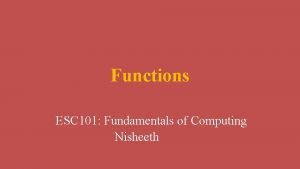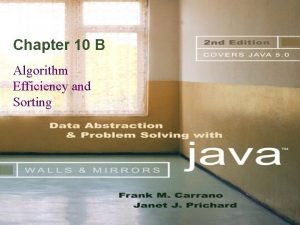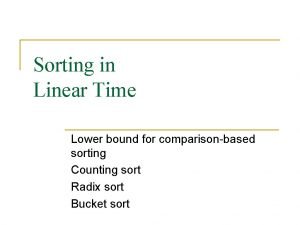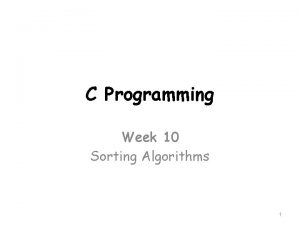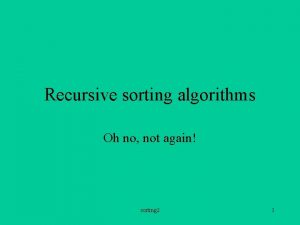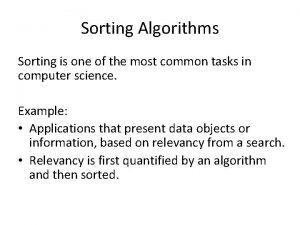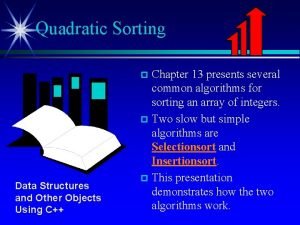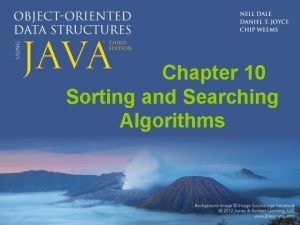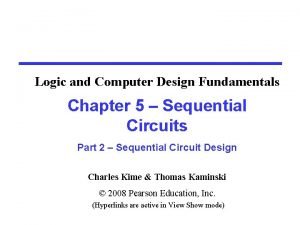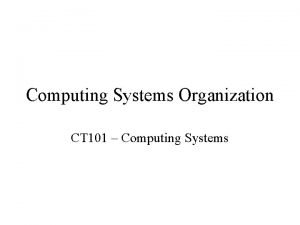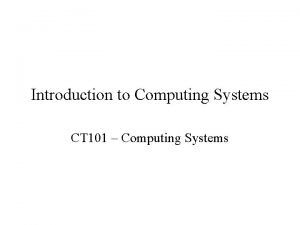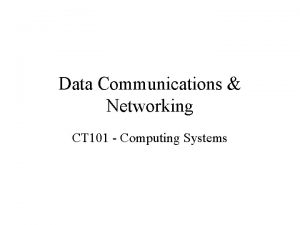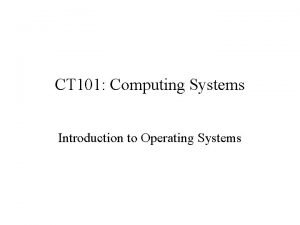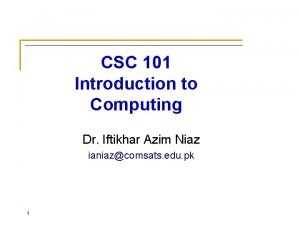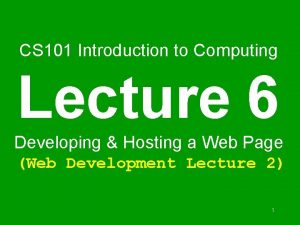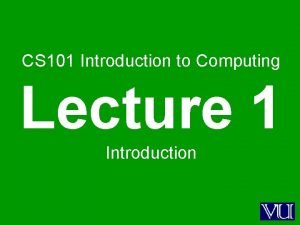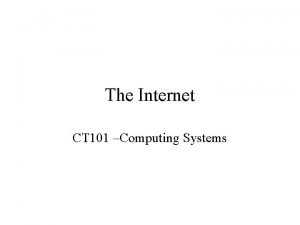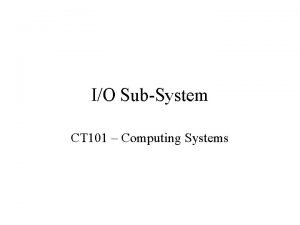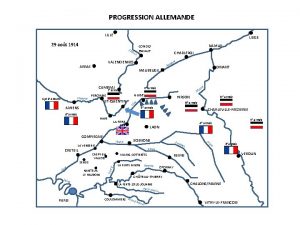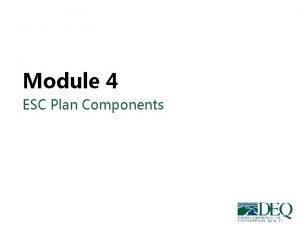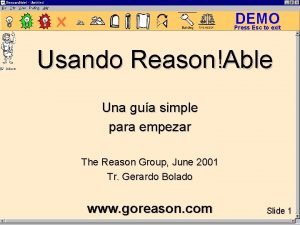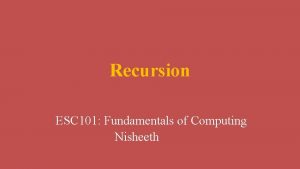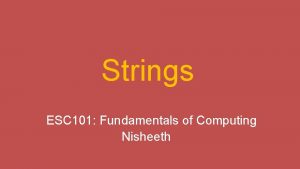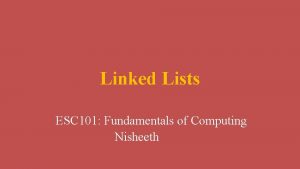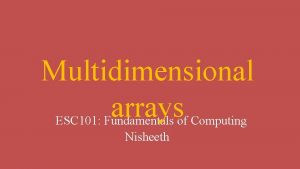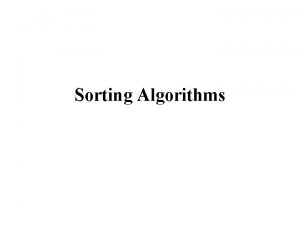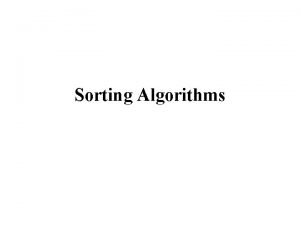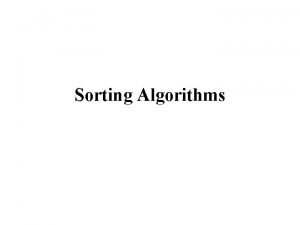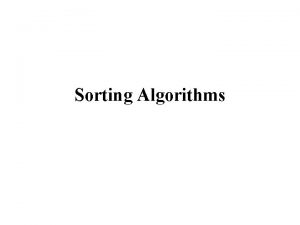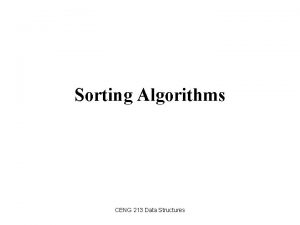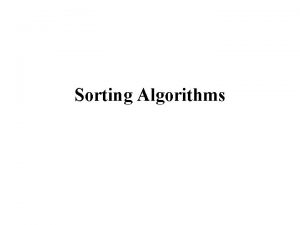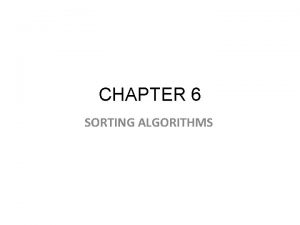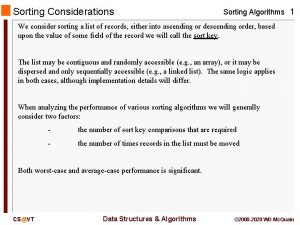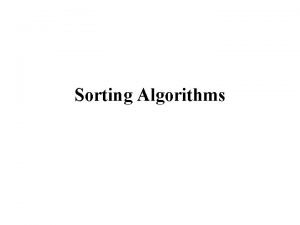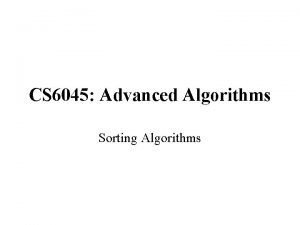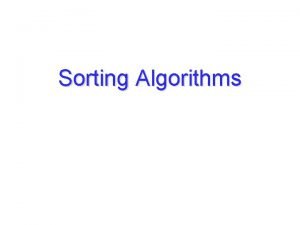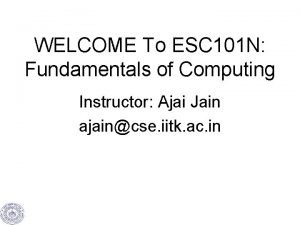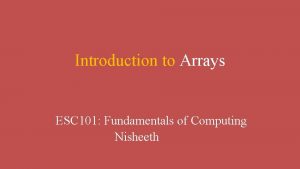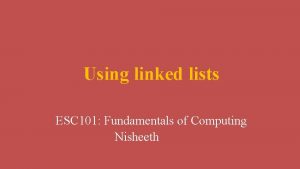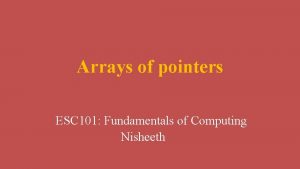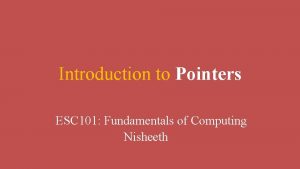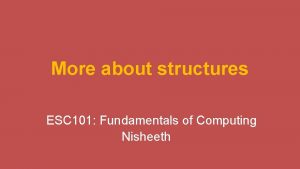Sorting algorithms ESC 101 Fundamentals of Computing Nisheeth






























- Slides: 30

Sorting algorithms ESC 101: Fundamentals of Computing Nisheeth 1

250 What is Sorting? “ Time-taken Useful in itself – internet search and recommendation systems 200 150 100 50 50 100 150 200 250 300 350 No. of items Sorting is the process of arranging items systematically, ordered by some criterion Search within n unsorted elements can take as much as O(n) operations 400 ” Makes searching very fast – can search within n sorted elements in just O(log n) operations using Binary Search 2 ESC 101

Sorting Algorithms Bubble Sort 3 ESC 101

Bubble Sort • Consider an array (5 1 4 2 8). Goal: Sort it in ascending order • Idea: Repeatedly swap the adjacent elements if they are in wrong order Second Pass First Pass Third Pass No swaps in this pass, hence done! 4 ESC 101

Bubble Sort 5 ESC 101

Sorting Algorithms Selection Sort 6 ESC 101

Selection Sort • 4 1 3 5 6 8 9 7 ESC 101

Selection Sort • 4 1 3 5 6 8 9 8 ESC 101

Selection Sort • Once an element goes to non-active region, we never touch it again • To maintain our conditions and still shrink the active region • We find the largest element in the active region • Bring it to the right-most end of the active region using a swap 4 1 3 5 6 8 9 Verify that our conditions still hold 3 1 4 5 6 8 9 9 ESC 101

Selection Sort Exercise: write a recursive version Exercise: convert this to proper C code 10 ESC 101

Time Complexity • 11 ESC 101

Summary so far. . 250 • 150 200 100 50 50 100 150 200 250 300 350 400 2500 2000 1500 1000 500 12 ESC 101

Partition based Sorting Techniques • 13 ESC 101

Sorting Algorithms Merge Sort 14 ESC 101

Merge Sort 9 1 1 1 9 2 1 4 2 ? Merge Sort 2 4 2 2 1 7 2 2 9 3 7 5 8 9 1 2 ? Merge 4 4 5 3 5 2 1 4 8 ? Merge Sort 3 4 5 5 8 8 5 7 8 8 9 9 Trick: Merging two sorted arrays is very easy! 15 ESC 101

Merge Sort A sort algorithm is called in-place if it does not use extra memory e. g. extra arrays, to sort the given array 16 ESC 101

Time Complexity • 17 ESC 101

The Merge Operation • 18 ESC 101

The Merge Operation 1 1 2 2 4 7 9 9 1 2 3 4 5 5 8 8 5 7 8 8 9 9 Merge 1 1 1 2 2 2 3 4 4 5 9 8 is larger: A B wins again 19 ESC 101

The Merge Operation 20 ESC 101

Sorting Algorithms Quick Sort 21 ESC 101

Quick Sort • 22 ESC 101

The Partition Technique • 9 1 9 4 2 1 2 7 5 8 3 5 2 1 4 8 1 2 2 1 3 8 4 5 8 5 7 4 9 9 23 ESC 101

Quick Sort 1 2 2 1 3 8 4 5 8 5 7 4 9 9 • 24 ESC 101

Quick Sort Most popular, inexpensive Also common, inexpensive Ensures balanced partition but expensive 25 ESC 101

The Partition Procedure • The partition procedure maintains an interesting structure of one active region sandwiched between two inactive regions • Elements in the left inactive region are strictly less than the pivot, those in right invariant region strictly larger than pivot • What about element(s) equal to the pivot – need to be careful • We will see a visualization of the partition procedure in action • Note: these regions will be maintained on a separate array and not the original array – we will only take a simple left-to-right pass on the original array 26 ESC 101

The Procedure We Partition are sure now that any We blank will insert all occurrences of the PIVOT = 4 spaces left must be occurrences pivot element of 4 after we are done pivot 4 that we omitted earlierwith non-pivot elements 9 1 9 4 2 1 2 7 5 8 3 5 2 1 4 8 1 2 3 2 1 4 4 8 5 7 9 9 27 ESC 101

The Partition Procedure Hint: the in-place algorithm uses an identical notion of inactive regions but swaps elements at the boundaries of the regions which are wrongly placed Explore/invent yourself an in-place partitioning algorithm 28 ESC 101

Choice of Pivot • 9 1 8 4 2 1 2 7 5 8 3 5 2 1 4 8 1 2 2 1 3 8 4 5 8 5 7 4 8 9 29 ESC 101

Next class and next week. . • Wrap up the discussion on sorting • Hashing: a very efficient method for search • File handling in C • Solving numerical problems using programming • Future directions and wrapping up the course 30 ESC 101
 What is internal and external sorting
What is internal and external sorting Esc 101
Esc 101 Efficiency of sorting algorithms
Efficiency of sorting algorithms Sorting algorithms with examples
Sorting algorithms with examples Lower bound for comparison based sorting algorithms
Lower bound for comparison based sorting algorithms Sorting algorithms in c
Sorting algorithms in c N
N Clhelse
Clhelse Big o functions
Big o functions Most common sorting algorithms
Most common sorting algorithms Quadratic sorting algorithms
Quadratic sorting algorithms Place:sort=8&redirectsmode=2&maxresults=10/
Place:sort=8&redirectsmode=2&maxresults=10/ Introduction to sorting algorithms
Introduction to sorting algorithms Fundamentals of logical computing formulation
Fundamentals of logical computing formulation 101 computing
101 computing 101 computing
101 computing 101 computing network design
101 computing network design Operating system 101
Operating system 101 It 101 - introduction to computing
It 101 - introduction to computing Cs101 vu edu pk
Cs101 vu edu pk It 101 - introduction to computing
It 101 - introduction to computing 101 computing network
101 computing network Io subsystem
Io subsystem Conventional computing and intelligent computing
Conventional computing and intelligent computing Progression pédagogique esc
Progression pédagogique esc Esc region 1
Esc region 1 North point esc
North point esc Esc 18
Esc 18 Press esc to exit
Press esc to exit Esc region 1
Esc region 1 Esc lorain county
Esc lorain county

